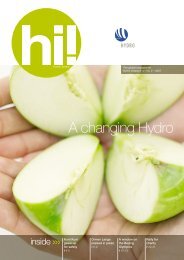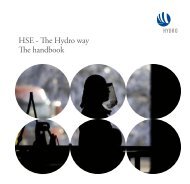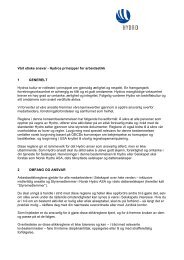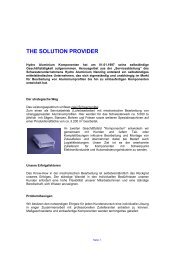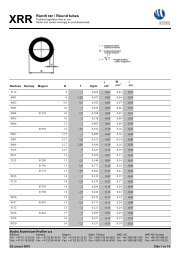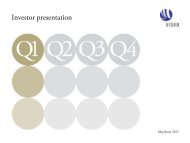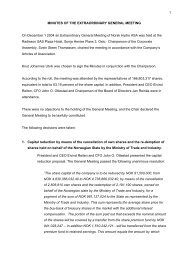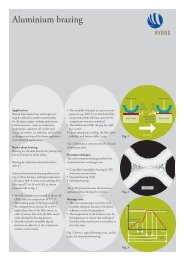Hydro Annual Report 2011b
Hydro Annual Report 2011b
Hydro Annual Report 2011b
You also want an ePaper? Increase the reach of your titles
YUMPU automatically turns print PDFs into web optimized ePapers that Google loves.
Notes to the consolidated financial statements<br />
FINANCIAL STATEMENTS<br />
Notes to the consolidated financial statements F7<br />
Note 1 - Significant accounting policies and reporting entity<br />
The reporting entity reflected in these financial statements includes Norsk <strong>Hydro</strong> ASA and consolidated subsidiaries (<strong>Hydro</strong>).<br />
<strong>Hydro</strong> is headquartered in Oslo, Norway, and the group employs around 23,000 people in more than 40 countries. <strong>Hydro</strong> is a<br />
fully integrated aluminium company with operations in all major activities along the industry value chain. Operations include<br />
power production, bauxite mining, alumina refining, aluminium smelting and remelting, and rolling and extrusion activities.<br />
<strong>Hydro</strong> is listed on the Oslo and London stock exchanges.<br />
The consolidated financial statements of Norsk <strong>Hydro</strong> ASA and its subsidiaries are prepared in accordance with International<br />
Financial <strong>Report</strong>ing Standards (IFRS) as issued by the International Accounting Standards Board (IASB) and the disclosure<br />
requirements as specified under the Norwegian Accounting Law (Regnskapsloven). All standards applied by <strong>Hydro</strong> have been<br />
endorsed by the European Union (EU) and Norwegian authorities and are effective as of December 31, 2011.<br />
The following description of accounting principles applies to <strong>Hydro</strong>'s 2011 financial reporting, including all comparative<br />
figures. See note 3 Basis of presentation and measurement of fair value, and note 4 Critical accounting judgment and key<br />
sources of estimation uncertainty for additional information related to the presentation, classification and measurement of<br />
<strong>Hydro</strong>'s financial reporting.<br />
Basis of consolidation<br />
The consolidated financial statements include Norsk <strong>Hydro</strong> ASA and subsidiaries, which are entities in which <strong>Hydro</strong> has the<br />
power to govern the financial and operating policies of the entity (control). Control is normally achieved through ownership,<br />
directly or indirectly, of more than 50 percent of the voting power. Currently, <strong>Hydro</strong> has more than 50 percent of the voting<br />
power in all subsidiaries. Subsidiaries are included from the date control commences until the date control ceases.<br />
Intercompany transactions and balances have been eliminated. Profits and losses resulting from intercompany transactions have<br />
been eliminated.<br />
Minority interests<br />
Minority interests represent non-controlling interests in subsidiaries. Minority interests are reported as a separate section of the<br />
Group's equity in accordance with IAS 27 Consolidated and Separate Financial Statements. Results attributed to minority<br />
interests are based on ownership interest or other method of allocation if required by contract. Dividends to minority<br />
shareholders are not presented separately.<br />
Business combinations<br />
Business combinations are accounted for using the acquisition method in accordance with IFRS 3 (revised 2008) Business<br />
Combinations (IFRS 3R). Consideration is the sum of the fair values, as of the date of exchange, of the assets given, liabilities<br />
incurred or assumed, and equity instruments issued in exchange for control of the acquiree. The fair value of <strong>Hydro</strong>'s<br />
preexisting ownership interest in an acquiree is included in the consideration, with any gain or loss recognized in Other<br />
income, net.<br />
The acquiree's identifiable assets, liabilities and contingent liabilities are recognized separately at the acquisition date at their<br />
fair value irrespective of any minority interest. Goodwill is initially measured either as the excess of the consideration over<br />
<strong>Hydro</strong>'s interest in the fair value of the acquiree's identifiable net assets (partial goodwill) or as the fair value of 100 percent of<br />
the acquiree in excess of the acquiree's identifiable net assets (full goodwill). The method is elected on a transaction-bytransaction<br />
basis. Goodwill is not amortized, but is tested for impairment annually and more frequently if indicators of possible<br />
impairment are observed, in accordance with IAS 36 Impairment of Assets. Goodwill is allocated to the cash generating units<br />
or groups of cash generation units expected to benefit from the synergies of the combination and that are monitored for<br />
internal management purposes.<br />
The interest of minority shareholders in the acquiree is initially measured as the minority's proportion of the fair value of the<br />
net assets recognized (partial goodwill method), or as the minority's proportion of the fair value of the acquiree (full goodwill<br />
method). Minority interests are subsequently adjusted for changes in equity after the acquisition date.



